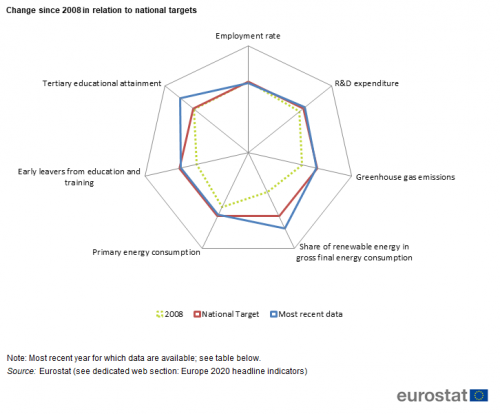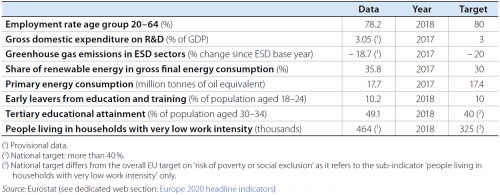Archive:Europe 2020 indicators - Denmark
Data extracted in August 2019.
No planned update.
This Statistics Explained article is outdated and has been archived - for recent information on Europe 2020 strategy see here.

Source: Eurostat (see dedicated web section: Europe 2020 headline indicators)
Explanations on this radar chart are available here.
This article is part of a set of statistical articles on Europe 2020 strategy, focusing on the situation in Denmark.
Full article
Overview
In 2018, Denmark exceeded its national target on tertiary educational attainment by 9.1 percentage points and was just 0.2 percentage points away from its target on early leavers from education and training. Denmark was one of the few countries to have met its R&D expenditure target of 3 % of GDP in 2017. With a 17.2 percentage point increase in the share of renewable energy in gross final energy consumption between 2008 and 2017, Denmark also surpassed its renewable energy target. In 2017, the country was also close to meeting its ESD GHG emissions and energy efficiency targets. The country’s employment rate in 2018 was still below the 2008 level and 1.8 percentage points behind the national target of 80 %. Between 2008 and 2018, the number of people living in households with very low work intensity — used in Denmark as a national target in the area of poverty and social exclusion — increased by 33.7 %, pushing the country further from its national target.

Source: Eurostat (see dedicated web section: Europe 2020 headline indicators)
Data sources
More information about the origin of the data and the calculation of indicators can be obtained via the Europe 2020 indicators dedicated website.
Under 'Main tables', click on the icons next to the indicators:
- 'Explanatory texts (metadata)' for a detailed overview of the collection and compilation methods;
- 'Information on the leaf' for data availability per country.
A more general overview of quality procedures can be found in Implementation of standard reference metadata for indicators - the ESMS Indicator Profile (ESMS-IP) (PDF file).
Context
Europe 2020 is the EU’s agenda for jobs and growth for the current decade. It emphasises smart, sustainable and inclusive growth as a way to strengthen the EU economy and prepare its structure for the challenges of the next decade. As a main objective, the strategy strives to deliver high levels of employment, productivity and social cohesion in the Member States, while reducing the impact on the natural environment.
Direct access to
- Towards robust quality management for European Statistics - Communication from the Commission to the European Parliament and the Council COM(2011) 211 final.
- Regulation (EC) No 223/2009 of 11 March 2009 on European statistics